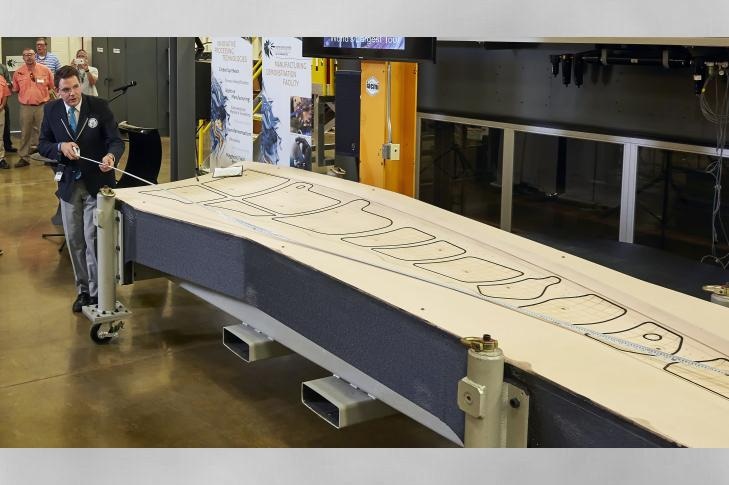Aug 30 2016
A 3D printed trim-and-drill tool, developed by researchers at the Department of Energy’s Oak Ridge National Laboratory to be evaluated at The Boeing Company, has received the title of largest solid 3D printed item by GUINNESS WORLD RECORDS™.
 Official measurement of the 3D printed trim tool co-developed by Oak Ridge National Laboratory and The Boeing Company exceeded the required minimum size to achieve the GUINNESS WORLD RECORDS title of largest solid 3D printed item. (Credit: Oak Ridge National Laboratory)
Official measurement of the 3D printed trim tool co-developed by Oak Ridge National Laboratory and The Boeing Company exceeded the required minimum size to achieve the GUINNESS WORLD RECORDS title of largest solid 3D printed item. (Credit: Oak Ridge National Laboratory)
ORNL printed the lower cost trim tool in only 30 hours using carbon fiber and ABS thermoplastic composite materials, which will be tested in building the Boeing 777X passenger jet. At 17.5 feet long, 5.5 feet wide and 1.5 feet tall, the 3D printed structure is comparable in length to a large sport utility vehicle and weighs approximately 1,650 pounds.
“The existing, more expensive metallic tooling option we currently use comes from a supplier and typically takes three months to manufacture using conventional techniques,” said Leo Christodoulou, Boeing’s director of structures and materials. “Additively manufactured tools, such as the 777X wing trim tool, will save energy, time, labor and production cost and are part of our overall strategy to apply 3D printing technology in key production areas.”
During an awards ceremony held at DOE’s Manufacturing Demonstration Facility at ORNL, where the component was 3D printed on the lab’s Big Area Additive Manufacturing machine, GUINNESS WORLD RECORDS judge Michael Empric measured the trim tool, proved it exceeded the required minimum of 0.3 cubic meters, or approximately 10.6 cubic feet, and announced the new record title.
“The recognition by GUINNESS WORLD RECORDS draws attention to the advances we’re making in large-scale additive manufacturing composites research,” said Vlastimil Kunc, leader of ORNL’s polymer materials development team. “Using 3D printing, we could design the tool with less material and without compromising its function.”
After ORNL completes verification testing, Boeing plans to use the additively manufactured trim-and-drill tool in the company’s new production facility in St. Louis and provide information back to ORNL on the tool’s performance. The tool will be used to secure the jet’s composite wing skin for drilling and machining before assembly.
Production of the 777X is scheduled to begin in 2017 and first delivery is targeted for 2020.
The project is supported by DOE’s Office of Energy Efficiency and Renewable Energy – Advanced Manufacturing Office. AMO supports applied research, development and demonstration of new materials and processes for energy efficiency in manufacturing as well as platform technologies for the manufacturing of clean energy products. AMO also provides support for ORNL’s Manufacturing Demonstration Facility, a public-private partnership to engage industry with national labs. For more information, visit ORNL’s Innovations in Manufacturing website.
UT-Battelle manages ORNL for DOE’s Office of Science. The Office of Science is the single largest supporter of basic research in the physical sciences in the United States, and is working to address some of the most pressing challenges of our time. For more information, please visit http://science.energy.gov/.
Source: https://www.ornl.gov/